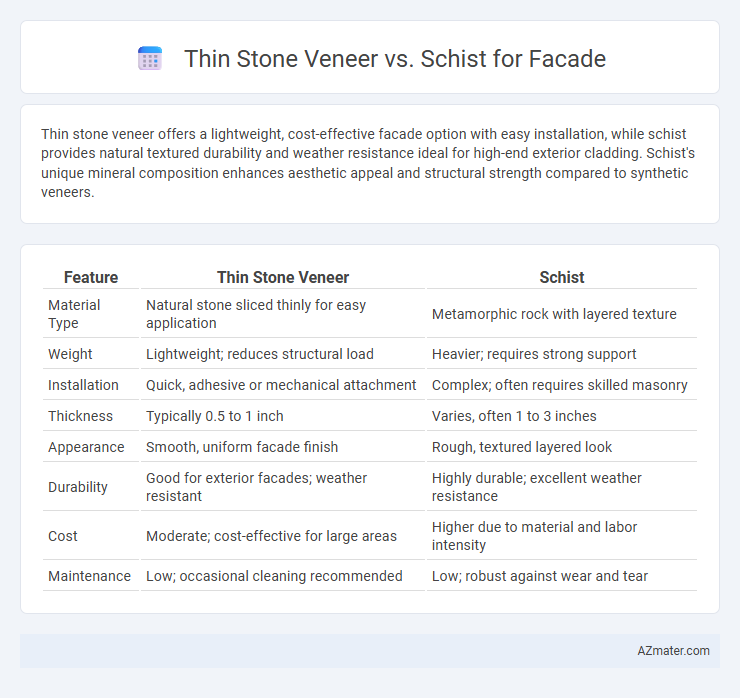Thin stone veneer offers a lightweight, cost-effective facade option with easy installation, while schist provides natural textured durability and weather resistance ideal for high-end exterior cladding. Schist's unique mineral composition enhances aesthetic appeal and structural strength compared to synthetic veneers.
Table of Comparison
| Feature | Thin Stone Veneer | Schist |
|---|---|---|
| Material Type | Natural stone sliced thinly for easy application | Metamorphic rock with layered texture |
| Weight | Lightweight; reduces structural load | Heavier; requires strong support |
| Installation | Quick, adhesive or mechanical attachment | Complex; often requires skilled masonry |
| Thickness | Typically 0.5 to 1 inch | Varies, often 1 to 3 inches |
| Appearance | Smooth, uniform facade finish | Rough, textured layered look |
| Durability | Good for exterior facades; weather resistant | Highly durable; excellent weather resistance |
| Cost | Moderate; cost-effective for large areas | Higher due to material and labor intensity |
| Maintenance | Low; occasional cleaning recommended | Low; robust against wear and tear |
Introduction to Façade Material Choices
Thin stone veneer offers a lightweight, cost-effective alternative to natural stone for facades, providing authentic texture and durability with easier installation. Schist, a metamorphic rock, delivers unique layered aesthetics and exceptional weather resistance, ideal for high-end architectural designs. Choosing between thin stone veneer and schist depends on factors such as budget, desired appearance, structural support, and long-term maintenance needs.
What is Thin Stone Veneer?
Thin stone veneer is a lightweight, natural stone layer typically 1 to 2 inches thick, used as a decorative and protective facade material. It offers the aesthetic appeal of solid stone without the heavy weight and structural demands, making it suitable for residential and commercial building exteriors. In comparison, schist, a naturally occurring metamorphic rock with a foliated texture, is often used as a thick, heavier stone option for facades, providing a rugged, textured appearance but requiring more substantial support.
Understanding Schist as a Building Material
Schist, a metamorphic rock known for its distinctive foliated texture and durability, offers a natural and elegant appearance for facades, making it a popular choice in architectural design. Compared to thin stone veneer, schist provides superior weather resistance and requires less maintenance due to its inherent strength and natural cleavage planes. Its unique mineral composition and layered structure enable precise cutting and installation, enhancing the aesthetic appeal and longevity of building exteriors.
Aesthetic Differences: Thin Stone Veneer vs Schist
Thin stone veneer offers a smooth, uniform appearance with consistent color and texture, making it ideal for modern, sleek facade designs. Schist displays a naturally rough, layered texture and varied mineral tones, providing an organic, rustic aesthetic that adds depth and character to exterior walls. Choosing between thin stone veneer and schist depends on whether a refined, controlled look or a rugged, natural appeal is desired for the building facade.
Durability and Weather Resistance Comparison
Thin stone veneer and schist both offer excellent durability for facades, but thin stone veneer typically provides enhanced resistance to chipping and cracking due to its engineered composition. Schist, a natural metamorphic rock, exhibits strong weather resistance withstanding temperature fluctuations and moisture well, yet it may require periodic sealing to prevent erosion and staining. When comparing weather resistance, thin stone veneer often outperforms schist in terms of protection against freeze-thaw cycles, making it a preferred choice in harsher climates.
Installation Processes and Techniques
Thin stone veneer offers a lightweight, easier installation process, often adhered directly to exterior walls using mortar or specialized adhesives, reducing labor time and structural support requirements compared to traditional stone. Schist, being a natural, heavier stone, typically requires more complex mechanical anchoring systems such as metal ties or clips to ensure stability on facades, demanding experienced craftsmanship and precise measurements. The choice between thin stone veneer and schist impacts installation speed, cost, and necessary structural modifications due to their differing thicknesses, weights, and backing materials.
Maintenance Requirements Over Time
Thin stone veneer demands minimal maintenance due to its lightweight structure and sealed surface, reducing the risk of water infiltration and cracking over time. Schist, being a natural metamorphic rock with layered mineral composition, requires regular inspection and occasional sealing to prevent moisture absorption and flaking, especially in harsh weather conditions. Both materials benefit from periodic cleaning and prompt repair of damaged areas to preserve aesthetic appeal and structural integrity.
Cost Analysis: Thin Stone Veneer vs Schist
Thin stone veneer offers a cost-effective solution for facade applications, typically priced between $6 to $12 per square foot, significantly lower than natural schist which ranges from $10 to $25 per square foot due to extraction and processing expenses. Installation costs for thin stone veneer are also reduced because of its lighter weight and ease of handling compared to schist, which requires specialized labor and equipment. Material durability and long-term maintenance costs favor schist, but initial budget constraints often make thin stone veneer the preferred choice for economical facade projects.
Environmental Impact and Sustainability
Thin stone veneer offers a lower environmental impact due to its reduced material extraction and lighter weight, which lowers transportation emissions compared to natural Schist. Schist, a natural metamorphic rock, requires more extensive quarrying, leading to larger ecological disturbance and greater energy consumption in processing. Sustainable facade choices favor thin stone veneer for its resource efficiency and lower carbon footprint while maintaining aesthetic appeal.
Choosing the Best Material for Your Façade
Thin stone veneer offers lightweight installation and cost-effective solutions with a wide range of natural stone aesthetics suitable for various architectural styles. Schist provides a durable, textured facade with excellent weather resistance and unique crystalline patterns, enhancing visual appeal and longevity. Selecting the best material depends on factors like budget, desired texture, climate conditions, and structural support capacity.

Infographic: Thin stone veneer vs Schist for Facade
 azmater.com
azmater.com